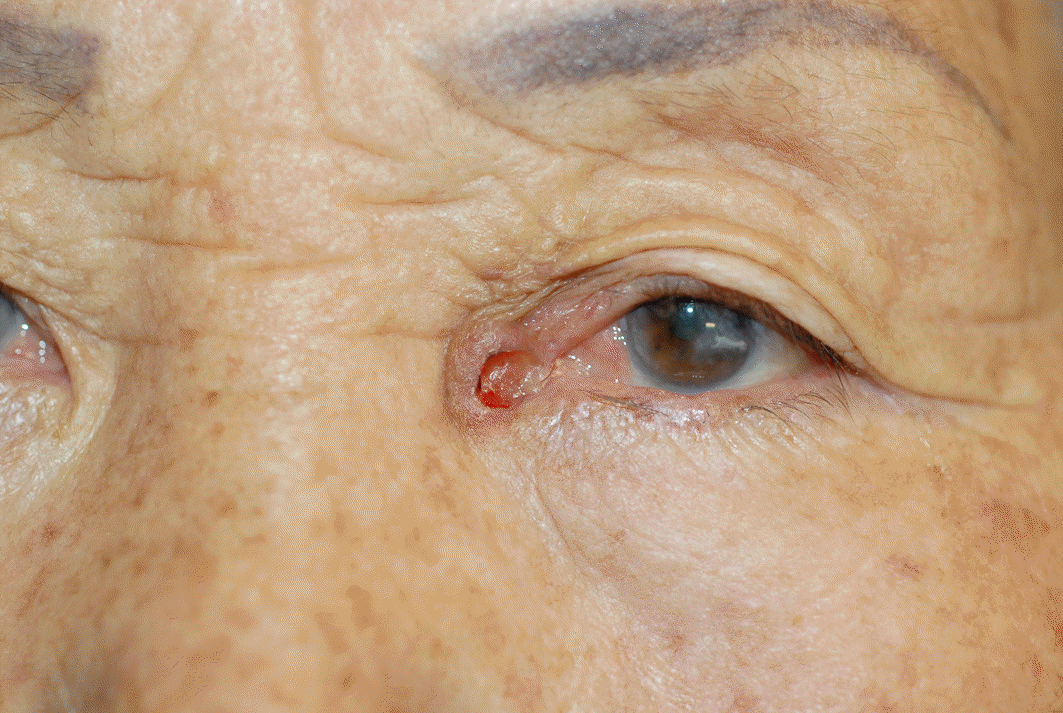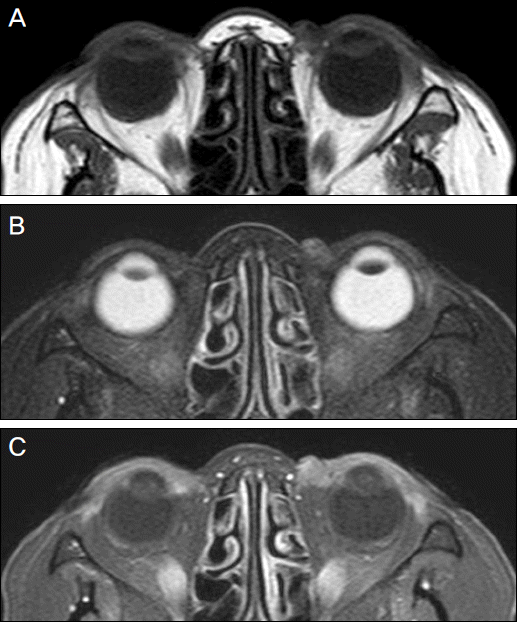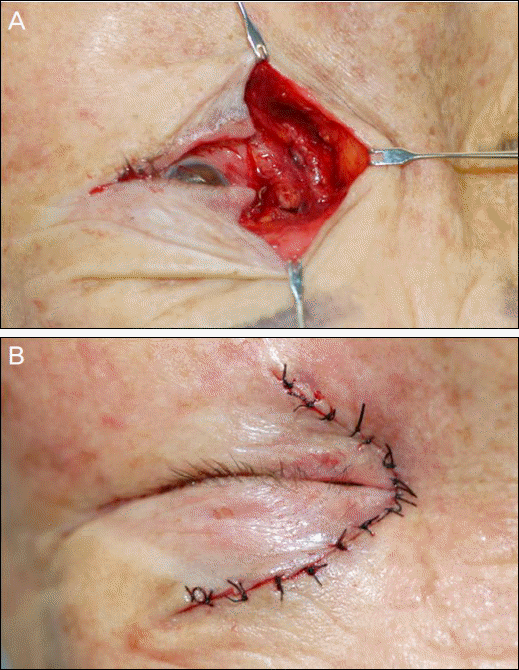Abstract
Purpose
Eccrine ductal carcinoma is an extremely rare tumor that arises in the eccrine sweat glands. The authors of the present study describe a case of an eyelid mass diagnosed as eccrine ductal carcinoma.
Case summary
A 74-year-old woman visited our institute with a 3-month history of a mass in the left medial canthus. The lesion appeared as a solitary nodule with central ulceration. A magnetic resonance imaging (MRI) of the orbit showed a relatively well enhanced 0.8 cm × 0.8 cm-sized ovoid soft tissue mass. A mass excision was performed under frozen section control. The tumor was completely excised with margin clearance and medial canthal reconstruction was performed. Histopathological examination revealed a tumor composed of numerous duct-like structures lined with pleomorphic cuboidal epithelium that was diagnosed as eccrine ductal carcinoma of the eyelid.
Go to : 
References
1. Wick MR, Goellner JR. Wolfe JT 3rd, Su WP. Adnexal carcinomas of the skin. I. Eccrine carcinomas. Cancer. 1985; 56:1147–62.
2. Krishnakumar S, Mohan ER, Babu K, et al. Eccrine duct carcinoma of the eyelid mimicking meibomian carcinoma: Clinicopathological study of a case. Surv Ophthalmol. 2003; 48:439–46.

3. Urso C, Bondi R, Paglierani M, et al. Carcinomas of sweat glands: report of 60 cases. Arch Pathol Lab Med. 2001; 125:498–505.
4. Kacker A, Shaha AR. Ductal eccrine carcinoma arising in the post-aural area. Ear Nose Throat J. 1999; 78:576–7.

5. Shin J, Koh JK, Kim KH, et al. A clinicopathologic study on eccrine tumors. Korean J Dermatol. 2006; 44:1273–83.
6. Elder DE, Elenitsas R, Jaworsky C, Johnson Jr B. Lever's histo-pathology of the skin. 9th ed. Philadelphia: Lippincott Williams & Wilkins;2005. p. 899–914.
7. Ohnishi T, Kaneko S, Egi M, et al. Syringoid eccrine carcinoma: report of a case with immunohistochemical analysis of cytokeratin expression. Am J Dermatopathol. 2002; 24:409–13.
8. Weber PJ, Hevia O, Gretzula JC, Rabinovitz HC. Primary mucinous carcinoma. J Dermatol Surg Oncol. 1988; 14:170–2.

9. Herrero J, Monteagudo C, Jordá E, Llombart-Bosch A. Squamoid eccrine ductal carcinoma. Histopathology. 1998; 32:478–80.

10. Voutsadakis IA, Bruckner HW. Eccrine sweat gland carcinoma: a case report and review of diagnosis and treatment. Conn Med. 2000; 64:263–6.
11. Park BW, Kim SI, Lee KS, Yang WI. Ductal eccrine carcinoma presenting as a Paget's disease-like lesion of the breast. Breast J. 2001; 7:358–62.

12. Urso C, Paglierani M, Bondi R. Histologic spectrum of carcinomas with eccrine ductal differentiation (sweat-gland ductal carcinomas). Am J Dermatopathol. 1993; 15:435–40.

13. Swanson PE, Cherwitz DL, Neumann MP, Wick MR. Eccrine sweat gland carcinoma: an histologic and immunohistochemical study of 32 cases. J Cutan Pathol. 1987; 14:65–86.

14. Wick MR, Ockner DM, Mills SE, et al. Homologous carcinomas of the breasts, skin, and salivary glands. A histologic and immunohistochemical comparison of ductal mammary carcinoma, ductal sweat gland carcinoma, and salivary duct carcinoma. Am J Clin Pathol. 1998; 109:75–84.
15. Swanson PE, Mazoujian G, Mills SE, et al. Immunoreactivity for estrogen receptor protein in sweat gland tumors. Am J Surg Pathol. 1991; 15:835–41.

16. Holds JB, Haines JH, Mamalis N, et al. Mucinous adenocarcinoma of the orbit arising from a stable, benign-appearing eyelid nodule. Ophthalmic Surg. 1990; 21:163–6.

17. Cruz DJ. Sweat gland carcinomas: a comprehensive review. Semin Diagn Pathol. 1987; 4:38–74.
Go to : 
 | Figure 1.Clinical photograph showing a firm mass with central ulceration in the medial canthal area of the left eye. |
 | Figure 2.(A) T1-weighted axial image demonstrating a poorly marginated mass with low signal intensity. (B) T2-weighted axial image demonstrating a heterogeneous high signal intensity in the left medial canthal area. (C) Contrast enhanced T1-weighted images demonstrating a relatively well enhancing soft tissue mass in the left medial canthal area. |
 | Figure 3.(A) Intraoperative photography showing a widely excised lesion with large defect. (B) A medial canthal reconstruction using advancement flap. |




 PDF
PDF ePub
ePub Citation
Citation Print
Print




 XML Download
XML Download